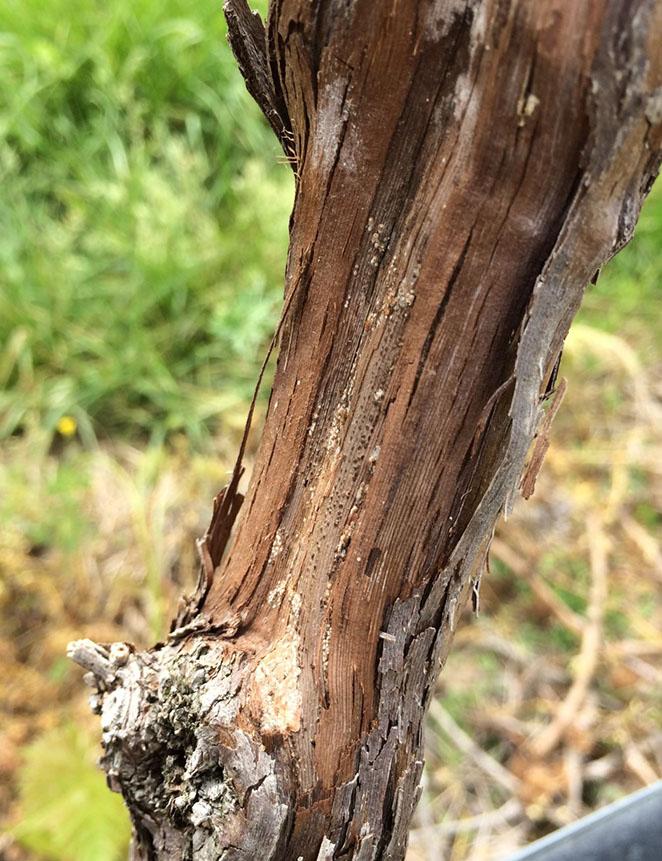Vinews
No. 7 — May 6, 2019
Contents:
- Scale Insects
- Cumulative Growing Degree Days for the Seven Grape Growing Regions of Missouri from April 1 to May 6, 2019
Scale Insects
Monitoring should start for grape scale in most areas of the state as growing degree days (base 50) near 400 since April 1.


Monitoring for Grape Scale
Monitoring for grape scale begins by identifying grape scale infested vines during the dormant season. The small white to tan scales can be found on trunks, cordons, and canes. Often times grape scales are difficult to find because they develop out of sight under loose bark. Therefore it is important to identify vines that are performing poorly during the season and mark or flag these vines for future follow up for potential monitoring of grape scale. Monitoring involves stripping bark from the base of vines and visually assessing the presence or absence of scale insects.
Grape scale infested vines can be monitored for grape scale crawlers using double sided tape wrapped tightly around an infested trunk, cordon or cane. Once 400 GDD at base 50 have accumulated since April 1 monitoring should begin. An alternative to doubled sided tape is to use black electrical tape coated with Vaseline to monitor for grape scale crawlers.
Management
Chemical control
Lorsban Advanced can be applied pre-bloom to manage grape scale. The use rate is 1 quart per acre and must be applied 35 days before harvest. The application timing should coincide when grape scale crawlers have just started to emerge and move, i.e. when crawlers are present on monitoring tape.
Lorsban Advanced cannot be used in conjunction with other Lorsban products and may only be applied once per year. Growers using Lorsban products to control grape root borer should consider using an alternative chemical control to manage Grape scale. Be aware that Lorsban Advanced is a restricted use product.
An alternative to Lorsban would be to apply Malathion 57EC at 1.5 pints/acre to control emerging crawlers. To further manage scale that have attached to trunks, cordons, or canes apply a 2% solution of Superior oil in early spring prior to bud swell.
Scale insects are virus vectors
Scale insects are known vectors of some of the Grapevine Leafroll viruses. Grapevine Leafroll associated virus 3 was the second most prevalent viruses found in the 2017 virus survey of Missouri vineyards. Grapevine Leafroll associated virus-3 is transmissible by 7 soft scale species.
Cumulative Growing Degree Days for the Seven Grape Growing Regions of Missouri from April 1 to May 6, 2019
| Region | Location by County | Growing Degree Days1 | ||
|---|---|---|---|---|
| 2019 | 2018 | 30-year Average | ||
| Augusta | St. Charles | 337 | 280 | 342 |
| Hermann | Gasconade | 347 | 282 | 341 |
| Ozark Highland | Phelps | 381 | 295 | 365 |
| Ozark Mountain | Lawrence | 392 | 302 | 354 |
| Southeast | Ste. Genevieve | 369 | 283 | 363 |
| Central |
Boone | 329 | 275 | 323 |
| Western | Ray | 299 | 255 | 305 |
1 Growing degree days at base 50 from April 1 to May 6, 2019. Data compiled from Useful and Useable at https://mygeohub.org/groups/u2u/tools. Click on link below to determine growing degree days in your area.
To determine the number of growing degree days accumulated in your area since April 1, use this tool.